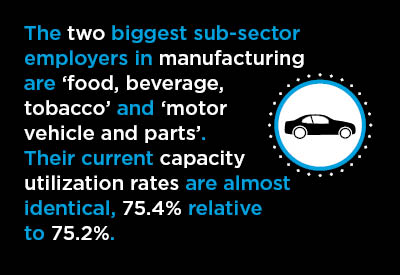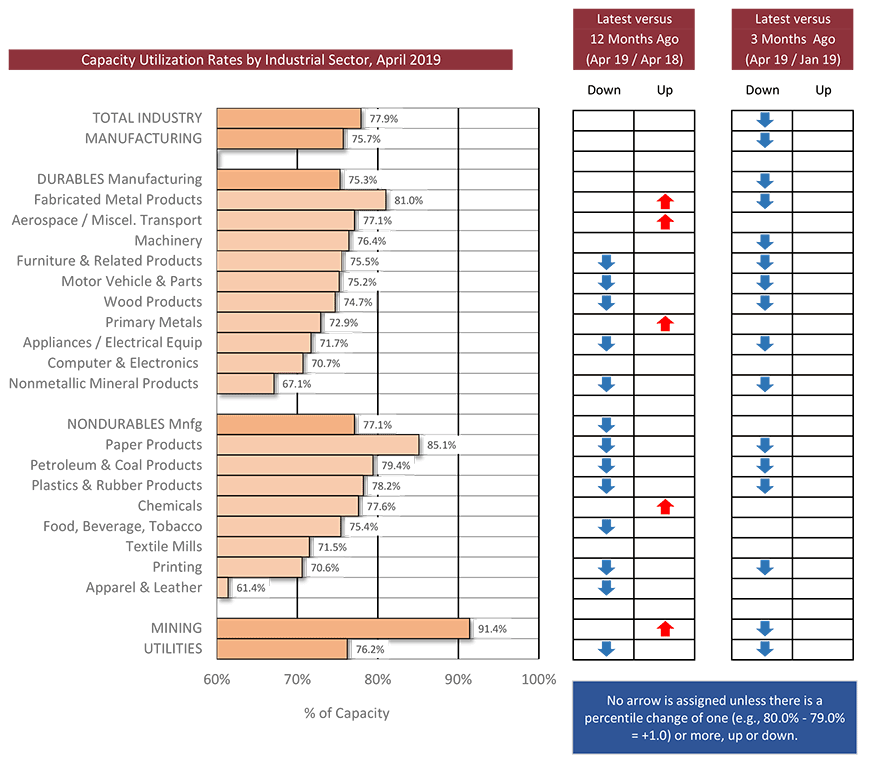There’s not a lot of encouragement for U.S. contractors in the latest industrial capacity utilization rate numbers. In April of this year, according to the Federal Reserve, ‘total industry’ in America operated at 77.9% of capacity, down from both 79.0% in January, a quarter prior, and from 78.8% in April of 2018, 12 months previously.

Usage Rates in Manufacturing, Mining and Utilities
The manufacturing sector’s plant usage rate in April 2019 was 75.7%, weaker than in January 2019, at 76.7%, and in April 2018, 76.6%. A similar pattern has held true for utilities: 76.2% in the latest reported month versus 77.3% three months prior and 81.7% twelve months prior.
Only mining, among major industrial sectors, has had a somewhat upbeat usage-rate. For starters, its level of capacity utilization has been much higher, 91.4% in April of this year. Also, its latest level of 91.4% is an improvement over 89.0% in April of last year, although it’s less than the 92.5% figure achieved in January 2019.
The capacity utilization rate is ‘actual’ output as a percentage of ‘full-blast’ output. History has shown that companies don’t begin to look seriously at spending on additional facilities until the plant usage rate in their industrial sector has reached at least 80.0%.
Furthermore, they won’t often commit to capital spending on new square footage when their industrial segment is experiencing a declining capacity utilization rate. Other factors, such as modernization to overcome obsolescence must come into play.
Construction firms take greatest delight in new or additional structures. With generally low and declining plant usage rates, they are facing disappointment. They can, however, derive comfort from renovation work designed to accommodate the introduction of more productivity-enhancing machinery and equipment on existing plant floors.
Capacity Utilization Retreats Far Outnumber Advances
Table 1 highlights the difficulties being encountered on the capacity utilization rate front. Within manufacturing, there are only two sub-sectors with current plant usage rates of 80.0% or more. Those two are fabricated metal products (81.0%) in durables manufacturing and paper products (85.1%) in nondurables. The former has a usage rate that is up year over year, but down versus a quarter ago. The latter is down on both a 12-months-ago and 3-months-ago basis.
On the right-hand side of Table 1, there are far more downward-pointing blue arrows than upward-pointing red arrows. Comparing April 2019 with April 2018, there are 13 instances of decline, illustrated by blue arrows, compared with only five of increases, encapsulated in the red arrows.
As for April 2019 relative to January 2019, there are nothing but blue arrows, 16 of them. There isn’t a single industrial sector that has recorded an uptick in its capacity utilization rate over the past three months.
Furthermore, the data has been seasonally adjusted (SA). Therefore, time-of-year factors – for example, weather and holidays − are not playing a role.

Table: ConstructConnect.
Negligible Effect of Tariffs on Production at Home
Over the past year, tariffs have been imposed on many of America’s chief trading partners in such product areas as refrigerators, softwood lumber, steel, aluminum and electronic products. A fair question to ask is whether this has been a spur to production at home.
Based on the capacity utilization rates of the sub-sectors with the most to gain from the tariffs, the answer seems to be in the negative. ‘Wood products’ (74.7%), ‘appliances and electrical equipment’ (71.7%), ‘textile mills’ (71.5%), ‘computer and electronics’ (70.7%) and ‘apparel and leather’ (61.4%) have all recorded plant usage rates recently that are less than three-quarters (75.0%).
‘Primary metals’ (72.9%) is the only sub-category positioned behind a tariff barrier that has raised its capacity utilization rate from a year ago, although it has not shifted over the past three months. In April 2018, ‘primary metals’ was operating at 71.1% and in January 2019, 73.0%.
Most business analysts are relieved that the U.S., Canada and Mexico have finally reached an agreement to discard their back-and-forth duties on steel and aluminum.
Moving on from the tariff discussion, the two biggest sub-sector employers in manufacturing are ‘food, beverage, tobacco’ and ‘motor vehicle and parts’. Their current capacity utilization rates are almost identical, 75.4% relative to 75.2%.
Nevertheless, Major Industrial Construction Projects
Usage rates aside, there have been recent groundbreakings on some large industrial construction projects.
In the motor vehicle sector, Alabama’s where the action has been. That state has seen starts on a Toyota-Mazda auto plant and a Mercedes Benz battery factory. Each project is valued at over a billion dollars.
Alabama has also starred in aerospace, recently winning a start-up on a Blue Origin manufacturing facility.
In computer electronics, Micron Technology has launched a plant expansion in Manassas Virginia for $3.0 billion.
Finally, Texas has been big in new mega-sized petroleum and chemical projects, with an ExxonMobil refinery expansion and a new ethane export facility. Texas is also where construction of some of the nation’s largest logistics centers are being initiated.

Table: ConstructConnect.










Recent Comments
comments for this post are closed